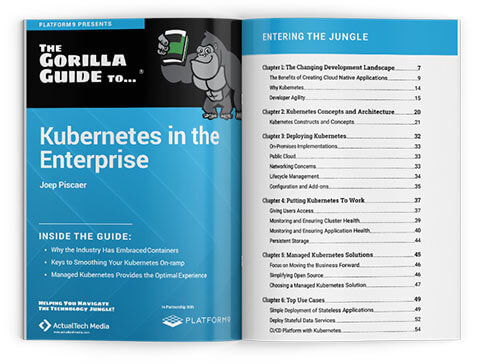This is an excerpt from The Gorilla Guide to Kubernetes in the Enterprise, written by Joep Piscaer.
Previous Chapters:
- Chapter 1: The Changing Development Landscape
- Chapter 2: Kubernetes Concepts and Architecture
- Chapter 3: Deploying Kubernetes
- Chapter 4: Putting Kubernetes to use: RBAC, Monitoring, Logging, Storage, & more
You can download the full guide here.
Managed Kubernetes Solutions
Running Kubernetes is still a lot of work, and requires deep domain expertise. More importantly, it takes time to design, implement and get into production. While the benefits of Kubernetes are massive, managing Kubernetes isn’t just set-it-and-forget-it.
Every business must give thought to the buy vs. rent paradigm. It comes down to evaluating cost and risk, and judging whether they’re outweighed by the advantages of a particular solution.
Building your own Kubernetes deployment is daunting. The consequences of making the wrong choices are long-lasting, and can impact application availability, performance, and agility. While building a solution in-house may be cheaper, your design might be of lesser quality or have flaws that will only be realized once you’re in production.
And really, what is the business problem you’re trying to solve with Kubernetes? It probably has to do with developer velocity, creating flow and reducing the work in progress. Having a sub-optimal platform will hurt those goals. This is the true value of a managed service: making sure the service delivered is top-notch. The service provider makes sure their Kubernetes environment is highly available, resilient, flexible, upto-date, secure, and efficient. Their job is to remove the toil and hassles of Kubernetes.
Why use a Managed Kubernetes service?
Focus on Moving the Business Forward
While installing and managing Kubernetes doesn’t move the business forward, quickly deploying new applications and versions to customers does. To developers – Kubernetes’ end users – platform availability is the key. They don’t care who builds it or how it gets there: they just want to get their hands on it, and for it to work well.
But although developers don’t care about the implementation details of a cluster or its operational state, someone still has to do the operational work to make sure the cluster is up to date, healthy, and secure.
A large part of that work consists of jobs like node lifecycle management, deploying new hosts, and making sure the hosts are kept up to date with the latest OS patches and container runtime versions.
Setting up a monitoring solution to keep an eye on Kubernetes infrastructure is notoriously difficult, and troubleshooting issues that arise is even more so. This can result in a huge time sink for admins and other infrastructure specialists, keeping them from helping developers solve their problems.
Simplifying Open Source
These reasons make it clear that for many organizations, a managed Kubernetes solution is the best option. The turnkey aspect of the service enables organizations to start working with an ecosystem of open source tools, like Kubernetes, quickly and securely.
Because for many organizations, it’s not just Kubernetes. Efforts usually also include Jenkins and other CI/CD tools, a suite of observability tools for logging, metrics, tracing and dashboards, various databases and key/value stores, pub/sub message queueing systems, and more.
Setting all these up before a developer can start using the ecosystem simply takes too much time, and can overwhelm an IT department. They need help from domain experts. Hiring outside consultants only partially solves this issue, as responsibility for any future work doesn’t shift. With a managed service, on the other hand, it does.
Choosing a Managed Kubernetes Solution
It’s important to choose a solution that solves these specific challenges:
- Deployment time
Deploying a Kubernetes Control Plane is a piece of cake for the MSP. Plugging in your various environments should be easy, quick and frictionless. - Monitoring and troubleshooting
Any issues in the environment should be surfaced and resolved automatically (where possible). For issues where manual intervention is needed, alerts should go out to the customer. - Ongoing operations for upgrades, fixes, and security patches
Managing Kubernetes is their specialty. That means the provider does the ongoing management and operations of the control plane, as well as the nodes. Upgrading Kubernetes versions and keeping the nodes up to date should be an invisible and smooth background process.
The Importance of ‘As-a-Service’ and SLAs
The risk of outsourcing a part of your infrastructure is sub-par quality from the Managed Service Provider (MSP). Making sure the provider keeps up their end of the deal, which is to provide a highly-available, secure and performant Kubernetes control plane, is key for a successful Kubernetes deployment.
This is why a service is preferred over a traditional software product. A product still needs to be installed, configured, and maintained by the customer; a service is a much more hands-off experience, with service-level agreements (SLAs) in place to offer and maintain a suitable service level.
Truly Multi-cloud and Hybrid Cloud
Public cloud has caught developers’ attention. They love the flexibility with which they can provision a new VM, container, key/value store or pub/sub message queue.
The downside is paying those public cloud bills. Even though public cloud is great, not everything must, or can, run in that environment for financial or data governance reasons. This means that the managed Kubernetes solution needs to be able to manage nodes across on-premises and public cloud boundaries.
Seamless Support for Other Workload Types
Containers solve a set of specific problems, but they’re not a silver bullet for everything. In most IT shops, there’s still a need for physical infrastructure and VMs, as well as higher-level abstractions like serverless. There’s also a plethora of services that offer ready-to-go functionality that you wouldn’t want to develop in-house, like mass-messaging via SMS or e-mail.
Kubernetes has a place inside this broader ecosystem but has to seamlessly support VMs, serverless computing, and third-party services. It’s critically important that the managed Kubernetes provider doesn’t force you to use their services for VMs, serverless or third-party services.
There’s More:
 On the next posts we’ll dive deeper into Kubernetes use cases – along with code samples to get you started – and best practices for operating Kubernetes in Production, at scale.
On the next posts we’ll dive deeper into Kubernetes use cases – along with code samples to get you started – and best practices for operating Kubernetes in Production, at scale.
Can’t wait?
To learn more about Kubernetes in the Enterprise, download the complete guide now.





